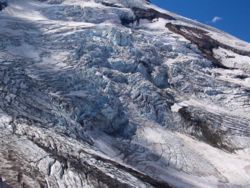Difference between revisions of "Cooper Spur"
From Oregon Hikers Field Guide
(Add information about David Cooper) |
|||
| (2 intermediate revisions by one user not shown) | |||
| Line 9: | Line 9: | ||
[[Category:Wildflowers]] | [[Category:Wildflowers]] | ||
[[Category:Wilderness]] | [[Category:Wilderness]] | ||
| + | [[Category:Destinations]] | ||
[[Image:Cooper Spur Summit.jpg|thumb|400px|Hikers reach the crest of Cooper Spur ''(Tom Kloster)'']] | [[Image:Cooper Spur Summit.jpg|thumb|400px|Hikers reach the crest of Cooper Spur ''(Tom Kloster)'']] | ||
| − | [[Image:Eliot Glacier Icefall.jpg|thumb|Icefall on the Eliot Glacier ''(Tom Kloster)'']] | + | [[Image:Eliot Glacier Icefall.jpg|thumb|250px|Icefall on the Eliot Glacier ''(Tom Kloster)'']] |
*Hikes to this destination: | *Hikes to this destination: | ||
| Line 18: | Line 19: | ||
{{maplinkinfo|latitude=45.37685|longitude=-121.67505}} | {{maplinkinfo|latitude=45.37685|longitude=-121.67505}} | ||
| − | * Elevation: | + | * Elevation: 8510 feet |
=== Description === | === Description === | ||
Cooper Spur is the highest point reached by formal trail on [[Mount Hood]]. From the rocky summit, there are stunning views of Mount Hood's north face, the massive ice falls of the Eliot Glacier to the north, and views across the smooth ice of the Newton Clark Glacier to the south. Oregon's high desert country spreads out to the east, and the orchards of the Hood River Valley spread out to the northeast. | Cooper Spur is the highest point reached by formal trail on [[Mount Hood]]. From the rocky summit, there are stunning views of Mount Hood's north face, the massive ice falls of the Eliot Glacier to the north, and views across the smooth ice of the Newton Clark Glacier to the south. Oregon's high desert country spreads out to the east, and the orchards of the Hood River Valley spread out to the northeast. | ||
| − | The large boulder perched on the narrow saddle between Cooper Spur and Mount Hood is Tie- | + | The large boulder perched on the narrow saddle between Cooper Spur and Mount Hood is Tie-in Rock, the traditional spot where climbers rope up before continuing toward the summit. The Cooper Spur route to the summit was once the most popular approach, in the days when the Cloud Cap Inn was the main tourist destination on the mountain. Today, it continues to be a popular climbing route for intermediate climbers. |
Other highlights at Cooper Spur include several stone windbreaks used for nearly a century by climbers and the etched signature in a small boulder left by a Japanese climbing party in the early 1900s. If you wait long enough on the crest, you might also be lucky enough to hear to hear the surreal crack and roar of the Eliot Glacier creaking down the mountain. | Other highlights at Cooper Spur include several stone windbreaks used for nearly a century by climbers and the etched signature in a small boulder left by a Japanese climbing party in the early 1900s. If you wait long enough on the crest, you might also be lucky enough to hear to hear the surreal crack and roar of the Eliot Glacier creaking down the mountain. | ||
Revision as of 23:58, 16 May 2020
- Hikes to this destination:
- Cooper Spur Hike (TH | <— —> | LOG)
- Cooper Spur via Tilly Jane Ski Trail Hike (TH | <— —> | LOG)
- Weather forecast: NWS/NOAA
- Maps: Oregon Hikers Maps Google Maps
- Latitude, Longitude: 45.37685, -121.67505
- Elevation: 8510 feet
Description
Cooper Spur is the highest point reached by formal trail on Mount Hood. From the rocky summit, there are stunning views of Mount Hood's north face, the massive ice falls of the Eliot Glacier to the north, and views across the smooth ice of the Newton Clark Glacier to the south. Oregon's high desert country spreads out to the east, and the orchards of the Hood River Valley spread out to the northeast.
The large boulder perched on the narrow saddle between Cooper Spur and Mount Hood is Tie-in Rock, the traditional spot where climbers rope up before continuing toward the summit. The Cooper Spur route to the summit was once the most popular approach, in the days when the Cloud Cap Inn was the main tourist destination on the mountain. Today, it continues to be a popular climbing route for intermediate climbers.
Other highlights at Cooper Spur include several stone windbreaks used for nearly a century by climbers and the etched signature in a small boulder left by a Japanese climbing party in the early 1900s. If you wait long enough on the crest, you might also be lucky enough to hear to hear the surreal crack and roar of the Eliot Glacier creaking down the mountain.
Cooper Spur is named after David Rose Cooper, who in 1885, constructed a steep 22-percent grade wagon road up to 6,000 feet and almost to the terminus of the Eliot Glacier. Visitors could then ascend this eastern slope of Mount Hood for views of the glacier, the rugged ridges, and Cascades volcanoes from Mount Rainier to Mount Jefferson. The road was soon purchased by William Ladd and C.E.S. Wood, who owned the Mount Hood Stage Company. Wood and Ladd built the existing Cloud Cap Road and constructed Cloud Cap Inn.
More Links
Page Contributors
- Splintercat (Tom Kloster) (primary)



